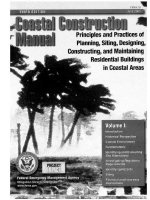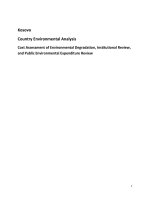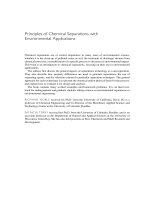Principles of Environmental Toxicology docx
Bạn đang xem bản rút gọn của tài liệu. Xem và tải ngay bản đầy đủ của tài liệu tại đây (161.25 KB, 5 trang )
1
Principles of
Environmental Toxicology
EnvS/FST 409/509
Instructor: Gregory Möller, Ph.D.
University of Idaho
Principles of Environmental Toxicology
Course
• Introductions.
• Enrollment.
– Drop/add deadlines.
– Reading, homework assignments, assessment.
– Student projects.
2
–
Exams.
– Graduate credit.
– Honor code.
• Web site; Web access via
student portal; ETox Live!
Blackboard/Skype/Second Life
/>Principles of Environmental Toxicology
Environmental Toxicology
• The study of the nature, properties, effects and
detection of toxic substances in the environment
and in any environmentally exposed species,
including humans.
3
Principles of Environmental Toxicology
Motivation
• Why learn about the environment and man’s
relationship to the environment?
4
Principles of Environmental Toxicology
One View
On earth creatures shall be seen who are constantly
killing one another. Their wickedness shall be limitless; their
violence shall destroy the world’s vast forests; and even after
they have been sated, they shall in no wise suspend their
desire to spread carnage, tribulations, and banishment among
all livin
g
bein
g
s. Their overreachin
g
p
ride shall im
p
el them to
5
gg gp p
lift themselves toward heaven. Nothing shall remain on earth,
or under the earth, or in the water, that shall
not be hunted down and slain, and
what is in one country, dragged
away into another; and their
bodies shall become the tomb
and the thoroughfare for all living
things they have ruined…
Principles of Environmental Toxicology
The fertile earth, following the law of growth, will
eventually lose the water hidden in her breast, and this water,
passing the through the cold and rarified air, will be forced to
end in the element of fire. Then the surface of the earth will be
burned, and that will be the end of all terrestrial nature.
6
— Leonardo Da Vinci, 1452-1519
2
Principles of Environmental Toxicology
Role of Science
Science is first of all a set of attitudes. It is a disposition
to deal with the facts rather than what someone has said about
them Science is a willingness to accept facts even when they
are opposed to wishes the opposite of wishful thinking is
intellectual honesty. Scientists have simply found that being
honest - with oneself as well as others - is essential to
Eitdtl
7
progress.
E
xper
i
men
t
s
d
o no
t
a
l
ways
come out as one expects, but the facts
must stand and the expectations fall.
The subject matter, not the scientist
knows best. (Skinner, 1953,
Science and Human Behavior
).
Principles of Environmental Toxicology
Course of Study
• Environmental Toxicology.
– A historical review.
– Human perspective; molecules of life.
• Concepts of toxicology.
•
Special topic: Pesticide residues.
8
Special
topic:
Pesticide
residues.
• Dose-response.
• Absorption.
• Distribution and storage.
Principles of Environmental Toxicology
Course of Study, 2
• Biotransformation and elimination.
• Target organ toxicity.
• Teratogenesis, mutagenesis, carcinogenesis.
• Special topic: Dioxins and related
compounds
9
compounds
.
• Exposure and risk
assessment.
Principles of Environmental Toxicology
Course of Study, 3
• Case studies:
1. Selenium Ecotoxicology.
2. Arsenic in Drinking Water.
• Abiotic transformation.
• Biotic transformation.
•
Environmental chemodynamics
10
•
Environmental
chemodynamics
.
• Environmental transport.
• Environmental chemicals.
Case studies.
• Monitoring environmental
chemicals.
Principles of Environmental Toxicology
Course of Study, 4
• Socrates Award: Poison of the Year.
• Regulating environmental chemicals.
• Special topic: Endocrine disruption.
• Future trends in environmental toxicology.
11
Principles of Environmental Toxicology
My Expectations
• Mortality and morbidity.
– Respect for life and the unfortunate people and
animals in case study depictions of toxicosis.
• Tolerance.
– Respect for different points of
idth itht
12
v
i
ew an
d
th
e pass
i
ons
th
a
t
drive them.
• You will do the
hard work of learning.
• Patience with technical failure.
3
Principles of Environmental Toxicology
Perceptions About Chemicals
• What drives our perceptions?
• Are chemicals bad?
• Can you save the planet with pesticides and
plastic?
13
Principles of Environmental Toxicology
Perception vs. Reality
• Perception:
– Pollution is a significant contributor to cancer and
that cancer rates are soaring.
• Reality:
– Life expectancy increasing in industrialized
Ames
14
countries.
– Cancer (non-smoking) death rates steady or going
down.
Principles of Environmental Toxicology
Cancer Death Rates - Male
ACS
15
Principles of Environmental Toxicology
Cancer Death Rates - Female
ACS
16
Principles of Environmental Toxicology
Perception vs. Reality, 2
• Perception
– High dose animal cancer tests tell us the
significant cancer risks for humans.
• Reality
–
Half of all chemicals-natural or s
y
nthetic-tested in
Ames
17
y
standard animal cancer tests have turned out to
be carcinogenic.
– Near toxic doses-the maximum
tolerated dose, can cause
chronic cell wounding or
mitosis – risk for cancer.
Principles of Environmental Toxicology
Perception vs. Reality, 3
• Perception
– Human exposures to carcinogens and other toxins are
nearly all due to synthetic chemicals.
• Reality
– Amount of synthetic pesticide residues in plant foods is
Ames
18
insignificant compared
to the amount of natural plant
pesticides.
– 5-10,000 natural pesticides
consumed, totaling
1500 mg/day.
4
Principles of Environmental Toxicology
Perception vs. Reality, 4
• Perception
– Synthetic toxins pose greater carcinogenic
hazards than natural toxins.
• Reality
– Proportion of natural chemicals that is
carcinogenic when tested in both rats and mice is
Ames
19
carcinogenic
when
tested
in
both
rats
and
mice
is
the same as for synthetic chemicals-roughly half.
– All chemicals are toxic
at some dose.
– 99.9% of chemicals
ingested are natural.
Principles of Environmental Toxicology
Perception vs. Reality, 5
• Perception
– Toxicology of man-made chemicals is different
from that of natural chemicals.
• Reality
– Humans have many general, natural defenses that
kllbffditl
Ames
20
ma
k
e us we
ll
b
u
ff
ere
d
aga
i
ns
t
norma
l
exposures
to toxins,
both natural and synthetic.
Principles of Environmental Toxicology
Perception vs. Reality, 6
• Perception
– Correlation implies causation.
• Reality
– No persuasive evidence from either epidemiology
or toxicology that pollution is a significant cause of
Ames
21
cancer for the general population.
Principles of Environmental Toxicology
Issues Beyond Cancer
• Workplace exposure.
• Endocrine disruption.
• Sub-clinical effects.
• Developmental effects.
•
Sensitive populations
22
•
Sensitive
populations
.
• Multiple exposures.
• Unknown effects.
Principles of Environmental Toxicology
Beyond Human Concern
• Unintended endpoints.
– Off target, off site
• “Confined” organisms.
• Species, genetic effects.
•
Biological effects at the
23
•
Biological
effects
at
the
organismal and population level.
• Food chain effects.
– Multi-trophic level.
– Bioconcentration.
Principles of Environmental Toxicology
Who is Responsible?
24
5
Principles of Environmental Toxicology
Making Things Clearer
25
Principles of Environmental Toxicology
Natural Carcinogens in Coffee
• Acetaldehyde
• Benzaldehyde
• Benzene
• Benzofuran
• Benzo[a]pyrene
•
Caffeic acid
• Ethylbenzene
• Formaldehyde
• Furan
•Furfural
• Hydrogen peroxide
•
Hydroquinone
26
•
Caffeic
acid
• Catechol
• 1,2,5,6 Dibenz-
anthracene
• Ethanol
•
Hydroquinone
• Limonine
• Styrene
• Toluene
• Xylene
Gold
Principles of Environmental Toxicology
Caffeine?
27









